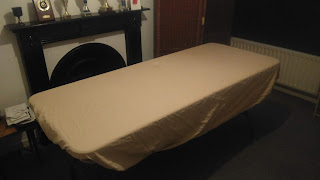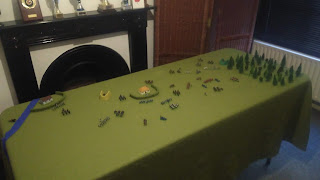THE Battle of Fontenoy was fought in this month 275 years ago between a French army under Maurice de Saxe and the Pragmatic army under its newly appointed commander, the Duke of Cumberland, who was the third and youngest son of Britain's King George II.
De Saxe got the campaigning season off to an early start in Flanders by feinting towards the city of Mons before suddenly switching to besiege Tournai, which was held by 7,000 Dutch troops.
De Saxe had more than 70,000 men - a very large force for the times, and apparently much larger than was suspected by France's enemies.
Cumberland marched to relieve Tournai with the polyglot Pragmatic army, formed of some 50,000 British, Dutch, Hanoverian and Austrian troops,
De Saxe left about a third of his force surrounding Tournai and moved with the rest to block Cumberland's line of approach.
He chose to make his stand with his right resting on the village of Antoing and the River Scheldt, and his left on the heavily wooded Bois de Barry. Between them, but nearer Antoing than the wood, was another village, Fontenoy.
De Saxe had both villages fortified, and built earthworks between them and also beside the Bois de Barry.
 |
| The battlefield of Fontenoy |
In our refight the French will be represented by nine battalions of regular foot, one battalion of grenadiers, a unit of light infantry, four squadrons of heavy horse, four squadrons of dragoons, three regular artillery batteries and, on the far side of the Scheldt, a battery of siege artillery (with a range of 36cm instead of the normal field artillery range of 24cm).
 |
| The battlefield with the French in position and awaiting the allies |
Naturally not every unit on my recreated battlefield can be matched with its namesake in the real battle.
 |
| The Piémont regiment is correctly shown occupying Antoing |
 |
| But the Chasseurs de Fischer lurking in the Bois de Barry should really be Arquebusiers de Grassin |
Be that as it may, the French at Fontenoy are generally reckoned to have had a slight edge in numbers.
Cumberland divided his army into a left wing composed mainly of Dutch troops, but with a large contingent of Austrian horse, and a right wing consisting of British and Hanoverian troops.
The left wing will be represented in our refight by four battalions of Dutch foot, a squadron of Dutch medium horse (the first time my Dutch troops will have seen action on my wargames table, as far as I can recall - they were painted with this battle in mind), two squadrons of Austrian dragoons, a squadron of Austrian cuirassiers and an artillery battery.
Cumberland gave this wing the task of assaulting Fontenoy, with the Austrian cavalry first directed to act as if they were, somewhat improbably, planning to attack Antoing.
The larger right wing will be represented by three battalions of regular British foot, a battalion of British grenadiers, two battalions of Hanoverian foot, two squadrons of British heavy horse, a squadron of British dragoons, a squadron of Hanoverian dragoons and two batteries of Royal Artillery.
 |
| The battlefield with the Pragmatic army in the foreground |
The right wing, or at least the infantry, advanced between Fontenoy and the wood, driving back the French foot before finally halting under pressure from in front and both flanks. They were then forced to retreat, but did so in good order, and there was no French pursuit.
Casualties on both sides were roughly even, but there was no doubt de Saxe was the winner. His army remained on the field of battle, and Tournai soon fell along with other important cities.
In terms of victory or army points, the French have de Saxe (3pts), 10 battalions of foot (20pts), eight squadrons of horse (8pts), four artillery batteries (4pts) and the Chasseurs de Fischer (1pt). That is a total of 36pts, so the French will have lost if the total falls below 18.
The Pragmatic army has Cumberland (3pts), 10 battalions of foot (20pts), eight squadrons of horse (8pts) and three artillery batteries (3pts). That is a total of 34pts, so the allies will have lost if their total falls below 17.
SPECIAL RULES
De Saxe is rated as a great general, meaning he will have a +1 modifier when rolling for the initiative, when trying to rally fleeing units and for whichever section of the army he is with when dicing for action points.
The Pragmatic Army's Royal Foot, Royal-Buffs Grenadiers and Royal Horse Guards have elite morale, as do de Saxe's Grenadiers de France and Gendarmes de la Garde.
The wood is passable to light infantry without any movement penalty. Other infantry may move through it at half-speed, but lose firing order (and therefore need a 6 rather than a 4 when rolling for hits). Britain's 5th Marines can fight as light infantry (in the real battle it was the Black Watch who could be used in this way).
British and Hanoverian foot have a 50:50 chance of a +1 modifier when firing.
A fortified village can be occupied by one battalion or by a gun and a light infantry unit; a redoubt by a gun or a light infantry unit or half a battalion. Troops behind the fortifications of a village or redoubt can fire from any point behind the fortifications without suffering any penalty for movement. If suffering a hit, they need a saving throw of 3 instead of the usual 4. Only infantry can melee against troops behind fortifications in a village, and only one unit can attack in a turn. Only infantry can melee frontally or from the flanks against troops in a redoubt, and only one unit can attack in a turn.
The allies are trying to break through to relieve Tournai, so they lose unless they reduce the French army to less than half its starting total of army points or they drive the French from the battlefield.
As already stated, the French battery beyond the Scheldt has a maximum range of 36cm but is otherwise treated as normal artillery.
Command & Control will be different from normal in that both armies were effectively split into two sections, a right and a left, rather than the usual three (a centre and two flanks), Accordingly, each army will roll a 12-sided die for action points, aka pips, for its larger flank (the French left and the Pragmatic right), and a 10-sided die for the smaller flank (the French right and and the Pragmatic left).














































